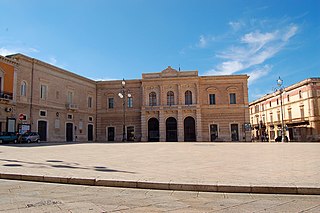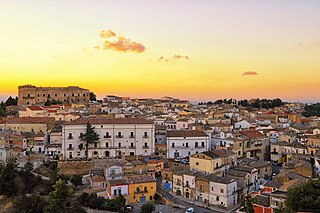You can help expand this article with text translated from the corresponding article in Italian. (September 2021)Click [show] for important translation instructions.
|
Trivicum is the ancient Hirpini and Samnium town nowadays called Trevico.
You can help expand this article with text translated from the corresponding article in Italian. (September 2021)Click [show] for important translation instructions.
|
Trivicum is the ancient Hirpini and Samnium town nowadays called Trevico.
The Roman poet Horace mentions Trivicum in his well-known account of a journey in 37 BC along the Appian Way from Rome to Brindisi:

Quintus Horatius Flaccus, commonly known in the English-speaking world as Horace, was the leading Roman lyric poet during the time of Augustus. The rhetorician Quintilian regarded his Odes as just about the only Latin lyrics worth reading: "He can be lofty sometimes, yet he is also full of charm and grace, versatile in his figures, and felicitously daring in his choice of words."

Gaius Cilnius Maecenas was a friend and political advisor to Octavian. He was also an important patron for the new generation of Augustan poets, including both Horace and Virgil. During the reign of Augustus, Maecenas served as a quasi-culture minister to the Roman emperor but in spite of his wealth and power he chose not to enter the Senate, remaining of equestrian rank.

Apulia, also known by its Italian name Puglia, is a region of Italy, located in the southern peninsular section of the country, bordering the Adriatic Sea to the east, the Strait of Otranto and Ionian Sea to the southeast and the Gulf of Taranto to the south. The region comprises 19,345 square kilometers (7,469 sq mi), and its population is about four million people. It is bordered by the other Italian regions of Molise to the north, Campania to the west, and Basilicata to the southwest. The regional capital is Bari.

The Appian Way is one of the earliest and strategically most important Roman roads of the ancient republic. It connected Rome to Brindisi, in southeast Italy. Its importance is indicated by its common name, recorded by Statius, of Appia longarum... regina viarum . The road is named after Appius Claudius Caecus, the Roman censor who, during the Samnite Wars, began and completed the first section as a military road to the south in 312 BC.

Otranto is a coastal town, port and comune in the province of Lecce, in a fertile region once famous for its breed of horses. It is one of I Borghi più belli d'Italia.

Sirocco, scirocco, or, rarely, siroc is a Mediterranean wind that comes from the Sahara and can reach hurricane speeds in North Africa and Southern Europe, especially during the summer season.

Ostuni is a city and comune, located about 8 km from the coast, in the province of Brindisi, region of Apulia, Italy. The town has a population of about 32,000 during the winter, but can swell to 200,000 inhabitants during summer, being among the main towns attracting tourists in Apulia. It also has a consistent British and German immigrant community and an industrial zone. The region is a producer of high quality olive oil and wine.

Salento, also known as Terra d'Otranto, is a cultural, historical and geographic region at the southern end of the administrative region of Apulia, in southern Italy. It is a sub-peninsula of the Italian Peninsula, sometimes described as the "heel" of the Italian "boot". It encompasses the entire administrative area of the province of Lecce, a large part of the province of Brindisi and part of that of Taranto.
Formia is a city and comune in the province of Latina, on the Mediterranean coast of Lazio, Italy. It is located halfway between Rome and Naples, and lies on the Roman-era Appian Way. It has a population of 38,095.

The province of Foggia is a province in the Apulia region of Italy.

Gnatia, Egnatia or Ignatia was an ancient city of the Messapii, and their frontier town towards the Salentini. As Egnazia Appula, it was a medieval bishopric, which remains a Latin Catholic titular see.

The House of Hauteville was a Norman family originally of seigneurial rank from the Cotentin. The Hautevilles rose to prominence through their part in the Norman conquest of southern Italy. By 1130, one of their members, Roger II, was made the first King of Sicily. His male-line descendants ruled Sicily until 1194. Some Italian Hautevilles took part in the First Crusade and the founding of the Principality of Antioch (1098).

Fasano is a town and comune in the Province of Brindisi, Apulia, southern Italy. It is the second most populated town in the province after Brindisi, with a population in 2021 of 39,026.

Ascoli Satriano is a town and comune in the province of Foggia in the Apulia region of southeast Italy. It is located on the edge of a large plain in Northern Apulia known as the Tavoliere delle Puglie.

The Gardens of Maecenas, or Horti Maecenatis, constituted the luxurious ancient Roman estate of Gaius Maecenas, an Augustan-era imperial advisor and patron of the arts. The property was among the first in Italy to emulate the style of Persian gardens. The walled villa, buildings, and gardens were located on the Esquiline Hill, atop the agger of the Servian Wall and its adjoining necropolis, as well as near the Horti Lamiani.

Salentino is a dialect of the Extreme Southern Italian spoken in the Salento peninsula, which is the southern part of the region of Apulia at the southern "heel" of the Italian peninsula.

Horace's Villa is a large ancient Roman villa complex near Licenza, Italy. The identification is likely because Horace wrote several poems about the place, and the special elaborate architectural features and location of the villa correspond to the descriptions in the poetry.

Strawberry Hill House—often called simply Strawberry Hill—is a Gothic Revival villa that was built in Twickenham, London, by Horace Walpole (1717–1797) from 1749 onward. It is a typical example of the "Strawberry Hill Gothic" style of architecture, and it prefigured the nineteenth-century Gothic Revival.

Aequum Tuticum was a Roman vicus in southern Italy, about 35 km east-northeast of Beneventum. The site lies beside Saint Eleuterio hamlet, overlooking Miscano Valley at an elevation of 575 m, about 15 km north of the modern Ariano Irpino, within Irpinia historical district. The vicus name is partly Latin and partly Oscan.